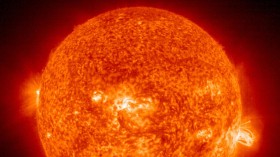A team of researchers has spotted a brown dwarf located 16,300 light years away.
Science Daily defines brown dwarfs as substellar objects floating freely in space which were too low in mass to sustain stable hydrogen fusion to fully develop into stars. Because of such characteristic, they are often labeled as failed stars. They are also too big to be considered planets and they have a mass roughly the same as the Sun. Often times they are tagged as the " missing link between stars and planets."
Interestingly, for stars roughly the mass of our Sun, it is rare that they orbit within three astronomical units of their host stars. This phenomenon is called the ‘brown dwarf desert.' The newfound brown dwarf named OGLE-2015-BLG-1319, may inhabit this desert, making this finding exceptional.
The data gathered by the survey suggest that the brown dwarf weighs between 30 and 65 Jupiter masses. It is found to orbit around a star named K dwarf, whose weight is equal to half of Sun's mass.
"We want to understand how brown dwarfs form around stars, and why there is a gap in where they are found relative to their host stars," said Yossi Shvartzvald, a NASA postdoctoral fellow based at NASA's Jet Propulsion Laboratory, Pasadena, California, and lead author of the study, in a press release. "It's possible that the 'desert' is not as dry as we think."
According to SciNews.com, the object was discovered using a technique called gravitational microlensing, and the help of NASA's Spitzer and Swift space telescopes. Microlensing is a technique done to spot low-mass celestial bodies and objects. This is the first time two space telescopes have collaborated to observe a microlensing event.
"In the future, we hope to have more observations of microlensing events from multiple viewing perspectives, allowing us to probe further the characteristics of brown dwarfs and planetary systems," said JPL scientist Geoffrey Bryden.
The new research was published this week in the Astrophysical Journal.
© 2024 NatureWorldNews.com All rights reserved. Do not reproduce without permission.
![Severe Thunderstorm Alert: Tornadoes, Damaging Winds and Hail Possible from Upper Ohio Valley to Northeast US [NWS]](https://1471793142.rsc.cdn77.org/data/thumbs/full/70161/280/157/50/40/severe-thunderstorm-alert-tornadoes-damaging-winds-and-hail-possible-from-upper-ohio-valley-to-northeast-us-nws.jpg)




